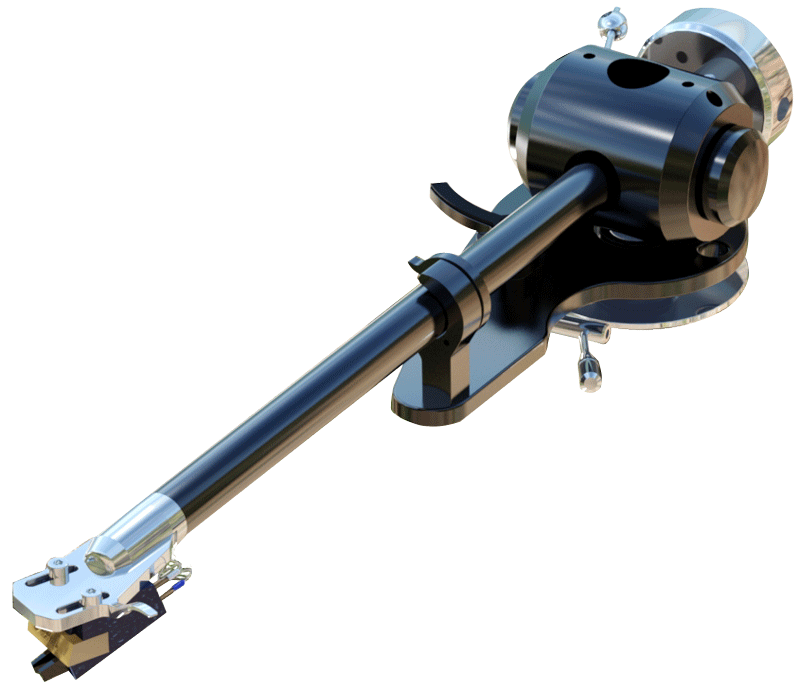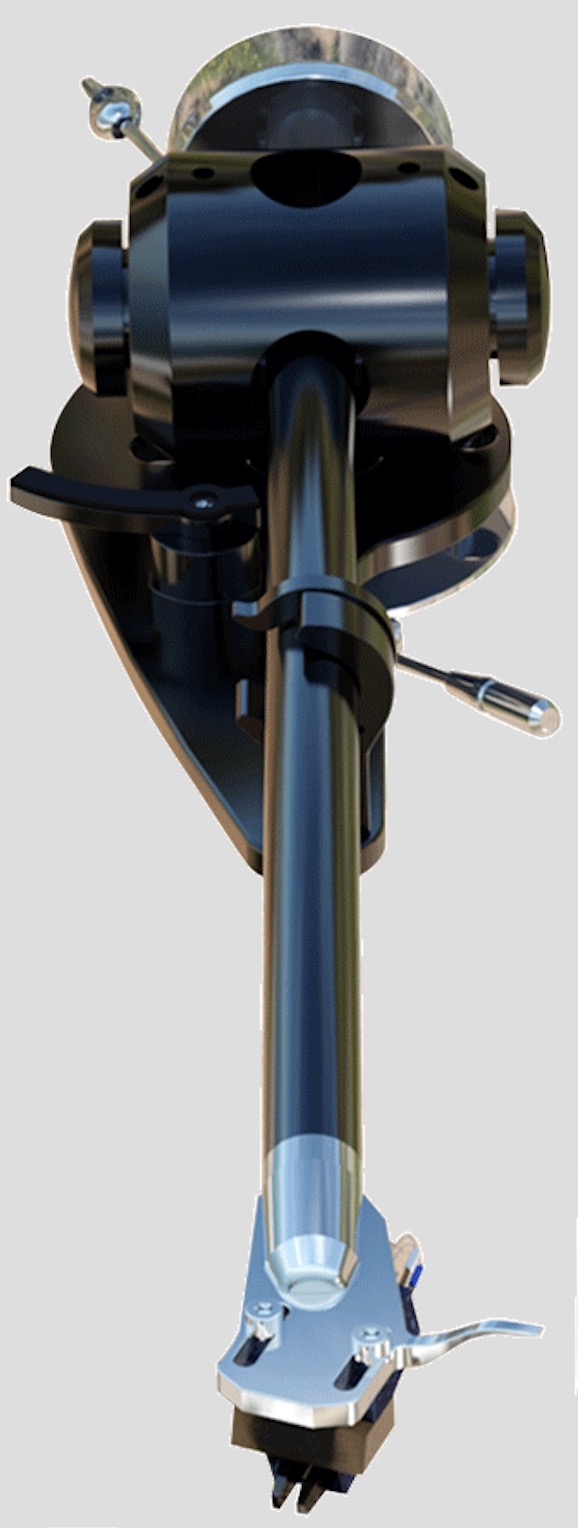The Article
Encounter 3c Tonearm From Origin Live
3rd March 2018

Created by popular demand, the 9.5” Origin Live Encounter 3c tonearm can be purchased in an extended form. Paul Rigby reviews the 12” version and performs a direct A-B test with the 9.5″ version to examine the sonic differences
Just half a mile from the Origin Live offices, the legendary Spitfire fighter plane was created by designer, RJ Mitchell. Born out of his Southampton-based office, the precursors to the WW2 legend, his S.5, S.6 and S.6B race-winning planes, successfully took part in the Schneider Trophy and contested the world air speed record.
That competitive streak also resides in the head of Origin Live boss, Mark Baker, “I sail in high performance, ex Olympic Class Tornado, 20ft twin trapeze Catamaran boats at Weston, off Southampton. Unfortunately, the Tornado national champion resides there too. It’s a tough life so there’s a continual battle to see who comes second. We regularly enter national and world championships in the Dart 18 class which we also sail. The latter features up to 150 boats in each race. Don’t ask me where I came though! I’m not professional, just an amateur.”
But you know what they say about us audiophiles and our general geeky nature, we can’t stop tweaking, can we? “I’m heavily into tuning,” said Baker, “because I have sailed competitively for so long. For example, there’s about 50 different factors to make a boat go faster, never mind the tactics on the course. Every bit of extra stiffness is very important. This tuning psyche is in my DNA. Take the carbon fibre boat masts. They vary greatly, there is a lot of technology that goes into a construction of a good mast.”
As Baker will tell you, there is carbon fibre and there is carbon fibre. To say that a mast or an Encounter 3c tonearm uses carbon fibre, means absolutely nothing. Aluminium can outperform a badly designed carbon fibre tonearm. It’s the way that carbon fibre is applied that makes the difference, “It’s a bit like the differences between balsa and ebony,” said Baker, “yet both are wood.”
Hence, when you look at the 12” Encounter 3c tonearm from Origin Live and you hear that it’s made from carbon fibre, don’t assume that it’s the stuff they use to make fishing rods or golf clubs, “Researching the right carbon fibre material has cost us a lot of time and money. Most people would gasp at spending £2,000 to do a simple tonearm test to investigate one property of carbon fibre. That’s how much it costs to do a single test and we have gone on from there to do many more.”
Such tests have taken place on the Encounter 3c. Normally produced to a 9.5” specification, the company has issued a 12” because of the large amount of requests, “…from Garrard owners, in particular,” said Baker. “That turntable is big enough to take them. We were also interested to see if a 12” version was truly better. There is a difference of opinion.”
The Encounter is in its fourth generation now. Based on the dual-pivot design, the carbon tube also includes ebony within it, “We used carbon fibre and ebony together because, as good as carbon fibre is at self damping, it still rings. Ebony is the best material for the price to enhance the damping.”
And dual pivot? It’s like a straight forward uni-pivot but, instead of having one point into a cup you have two. It pivots like the SME-based knife-edge bearing, “The advantage over the ‘knife’ is that the contact area is massively reduced,” said Baker. “That second ‘point’ moves in the vertical plane only, the horizontal point is handled by conventional bearings. The advantage is that you have very low friction and tremendous decoupling taking place. The bearing points are tungsten and the cups are made from hardened metal. We started with jewelled bearings but they tend to shatter.”
Origin Live use different metal alloys for the yoke depending on the grade of arm, “It’s not just the material costs but the machining costs of certain alloys. The Encounter is the low-end of the dual pivot range. It uses a lighter yoke,” said Baker.
The 12” version of the Encounter 3c might be longer but there is no threat of extra loading, which is minimal, “The arm supports could take a 100 times the strain. It’s massively over engineered,” said Baker.
SOUND QUALITY
I installed the 12” Encounter 3c onto an Origin Live Calypso turntable complete with a Dynavector 10×5 cartridge. The VTL IT-85 valve integrated amp plus Quad ESL-57 (One Thing modded) speakers completed the reference chain.
Spinning Chet Baker’s Chet Bakers Sings well recorded jazz LP, some arms take Baker’s almost choirboy-like delivery and focus on the high registers only. Of course, the Encounter 3c 12” addressed this area too but in a rather different manner. It wasn’t until I heard the 3c 12” that I realised that much of the competition can add an element of upper mid bloom which the 3c 12” removed completely. What resulted was a sharper, cleaner transcription that was also faster because of it. Other arms can also sometimes smear notes that stretch the vocal delivery. This far more focused rendition provided a clarity that also emphasised the silences in between the notes. The 3c 12” was also notable because it listed the lower frequencies within the Baker voice adding a bass balance that is too often ignored which added a little-heard texture to the Baker delivery that supplied and emphasised his emotive presentation.
The incisive detail offered by the 3c 12” was quite staggering. To the extent the off-mic shuffling and movements in and around the studio played a larger part in the performance which was enhanced by the broad soundstage and instrumental separation. Piano was light yet texturally complex, trumpets had an inoffensive metallic sheen while bass provided a solid grounding for the whole ensemble.
Changing to the more contemporary electronica of Autechre’s Cichlisuite, the extended piece was quite startlingly effective in the midband with its found sound samples forming a central rhythm, almost popping out of the centre of the soundstage while the synth backing sequence offered a soundscape of clean, controlled and almost romantic washes. Bass was almost dry in its focused control yet emoted a low frequency warmth of its own, forming a protective blanket around the track as a whole. A real eyebrow raising performance.
Moving on to rock with prog influences, and I have often been offended by the compressed overtones of Kansas’ Monolith LP. The Encounter 3c 12” approached this problem in a unique manner. It negates the compressive side effects by reducing the compressive impact. How does it do that?
Imagine you’re holding a piece of string, look closely at it. Look even closer than that and see that the string isn’t a single entity but a collection of finer threads working in unison. See how the threads group together for strength, how they lean and rely on each other, how they bend and twist yet retain their essential strong, malleability. Then move away from the string. With that information now in your head, you see the piece of string in a different way. It’s no longer a lumpen ‘thing’, it’s a co-operative collection of threads.
That’s what the Encounter 3c 12” does to music. Hence, because your brain sees each musical ‘thread’, the harsh frequencies no longer directly hit the ear all at the same time, in one leaden-like chunk. This fine examination of the individual aspects of each part of the music, allowed each detailed element to be appreciated on an individual basis.
Which is all well and good but is the 12” version of the Encounter 3c any different or better, aurally, than the standard issue 9.5”? I grabbed a second Calypso/Dynavector turntable and installed a 9.5” Encounter 3c to find out.
Spinning the Kansas LP, the 9.5” arm was lighter in the bass region than the 12” which portrayed a weightier, more confident aspect with a larger mass and presence. The 9.5” arm was lighter on its feet in midband terms. The air and spacious elements of its presentation was impressive, isolating the electric guitar strings and reflecting an almost ethereal and feather-light touch. The 12” added a balanced secondary percussion that displayed a rich tone that more naturally integrated itself within the soundstage while handling the compression issue with ease, displaying a more mature fashion. Vocal crescendos were brighter on the 9.5” but the 12” was both creamier and richer in its presentation.
Turning to Autechre’s electronica, the 9.5” produced an insightful mid performance, revealing new layers within the introductory synth sequence while the 12” had a greater low frequency shock effect when the bass first appeared, displaying a real wallop that gave the track presence which had a starker contrast with the found sound samples. The 9.5” arm did provide a melodic personality, the midrange incisiveness formed a rhythmic filigree pattern that danced over the broad soundstage but the 12’s richer presentation did add a sense of eloquent maturity, rounding off the samples, giving each a more realistic ‘thunk’.
Listening to the jazz of Chet Baker, the 9.5” offered a tremendous midrange performance with complex layering but the 12” told of a perceptive investigation into the mix, blending the more rounded mids with a new, added bass extension that took the arrangement into new areas, adding a degree of solidity, experience and a knowing wink.
CONCLUSION
If ever there was a case of swings and roundabouts within hardware comparison then the tonal differences between the 9.5” and 12” versions of the Encounter 3c was it. The 9.5” walked a lighter step. It produced finesse and style with fine detailing highlighting a star clarity. The 12” provided a bass extension that in no way swamped the soundstage but just pushed the arm’s awareness into a new, lower frequency range, opening the door into a grown-up arena that sounded both adult and rounded. Both arms produced superb quality sound yet I feel that the 12” arm, on this system, provided a better balance. It relaxed more into the mix, making sound production effortless and more natural. It was a close-run choice, though.
(And before I go, don’t forget the launch of my new Facebook Group – why not pop over and us? It’s already buzzing! Just click https://www.facebook.com/groups/theaudiophileman/)
ORIGIN ENCOUNTER MK.3c 12” Tonearm
Price: £1,745
Tel: 02380 578877
Web: www.originlive.com
GOOD: bass extension, mature presentation, incisive detail, dynamic
BAD: nothing
RATING: 8
REFERENCE
Origin Live Sovereign turntable
Origin Live Enterprise 12″ arm
Avid Acutus turntable
SME IV tonearm
Transfiguration Proteus cartridge
Dynavector 10×5 cartridge
Icon PS3 phono amplifier
VTL IT-85 amplifier
Aesthetix Calypso pre-amp
Icon Audio MB845 Mk.II monoblock amplifiers
Quad ESL-57 speakers with One Thing upgrade
Vertex AQ & Tellurium Q cable
Blue Horizon Professional Rack System
Harmonic Resolution Systems Noise Reduction Components
All vinyl was cleaned using an Audio Desk’s Ultrasonic Pro Vinyl Cleaner









There are several owner/customer reviews of OL arms that suggest quality and service from the company is not quite as advertised. But am sure reviewers get working products. If you are not a reviewer but a customer, be warned.
Hi Colin – if you have any personal experience of quality/service problems with OL, I’d be happy to forward your concerns to the company direct. Hopefully they can address those points and clear up any problems.